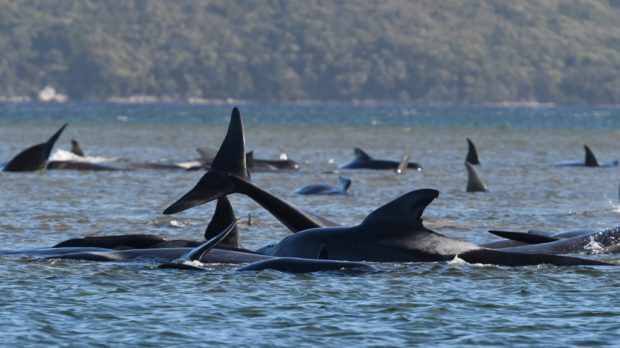
This photograph taken on September 21, 2020 shows a pod of whales stranded on a sandbar in Macquarie Harbour on the rugged west coast of Tasmania. – Up to 90 whales have died and a “challenging” operation is underway to rescue 180 more still stranded in a remote bay in southern Australia on September 22. Scientists said two large pods of long-finned pilot whales became stuck on sandbars in Macquarie Harbour, on Tasmania’s sparsely populated west coast. (Photo by – / POOL / AFP)
SYDNEY — Rescuers faced a race against time to save nearly 200 whales stuck in a remote Australian harbor on Tuesday, hoping to prevent the toll of 90 dead from rising further after managing to free “a small number” of the stranded mammals.
Scientists said two large pods of long-finned pilot whales became stuck on sandbars in Macquarie Harbour, on Tasmania’s rugged and sparsely populated west coast.
Images from the scene showed a shallow body of water, thick with scores of the large slick-black mammals manoeuvering for space.
About 60 people — including volunteers and local fish-farm workers – are involved in the rescue attempt and could be seen wading in the water to reach the whales to refloat them in deeper passages.
Government marine biologist Kris Carlyon said “about a third” of the 270 animals were dead by late Monday, and that rescuing survivors would be a “challenging” task likely to take several days.
But there were hopes Tuesday that early rescue efforts were already paying off, according to the official leading the operation.
“We have now freed a small number successfully that appear to have stayed out at sea, and are now scaling up that approach,” Parks and Wildlife Service manager Nic Deka said.
Though mass whale strandings occur relatively often in Tasmania, such a large group has not been seen in the area for more than a decade.
The animals are only accessible by boat, limiting the number of rescuers who can reach them.
They are battling chilly and rainy conditions as well as the harbor’s unusual tides, which are dictated by barometric pressure.
“In terms of mass whale strandings in Tasmania, this is up there with the trickiest,” Carlyon told reporters in the nearby town of Strahan.
However, Carlyon said many of the partially submerged whales should be able to survive for several days it would take his team to complete the task, in part due to the inclement weather.
“It’s pretty ugly for people on the ground but as far as the whales go it’s ideal – it’s keeping them wet, it’s keeping them cool,” he said.
Carlyon said rescuers would still have to “triage” the whales, prioritizing the healthiest and most accessible.
‘Notorious whale trap’
Most of a 30-strong group on a nearby beach were found dead Monday, while about 60 other whales on the sandbars are also believed to have since died.
Once the whales are returned to deeper water, Carlyon said, the biggest challenge will be herding the social creatures out of the sandbar-riddled harbor and back into the open ocean.
Scientists said it was unclear what caused the latest stranding, but Carlyon suggested the pod may have gone off track after feeding close to the shoreline or by following one or two whales that strayed.
Karen Stockin, an expert in marine mammals at New Zealand’s Massey University, said Tasmania was a “particular hotspot” for pilot whale strandings in large pods.
“It seems to be a notorious whale trap… you do tend to get these mass stranding events there,” she told AFP.
Stockin said that while pilot whales were typically more resilient than other whale species, rescuers faced a race against the clock as the mammals can overheat, their muscles deteriorate and their organs become crushed outside their natural environment.
“Time is never your friend,” she said. “So without a doubt, the more expedited rescue missions are, the more likely there is an increased (chance) of survival.”
Mike Double, the head of the Tasmania-based Australian Marine Mammal Centre, said it was “tragic” that such a “massive” pod had become stranded but other whales had previously been saved from the same location.
“The state team responsible for responding are extremely experienced and they’ll be absolutely working incredibly hard to get the best possible outcome,” he said.